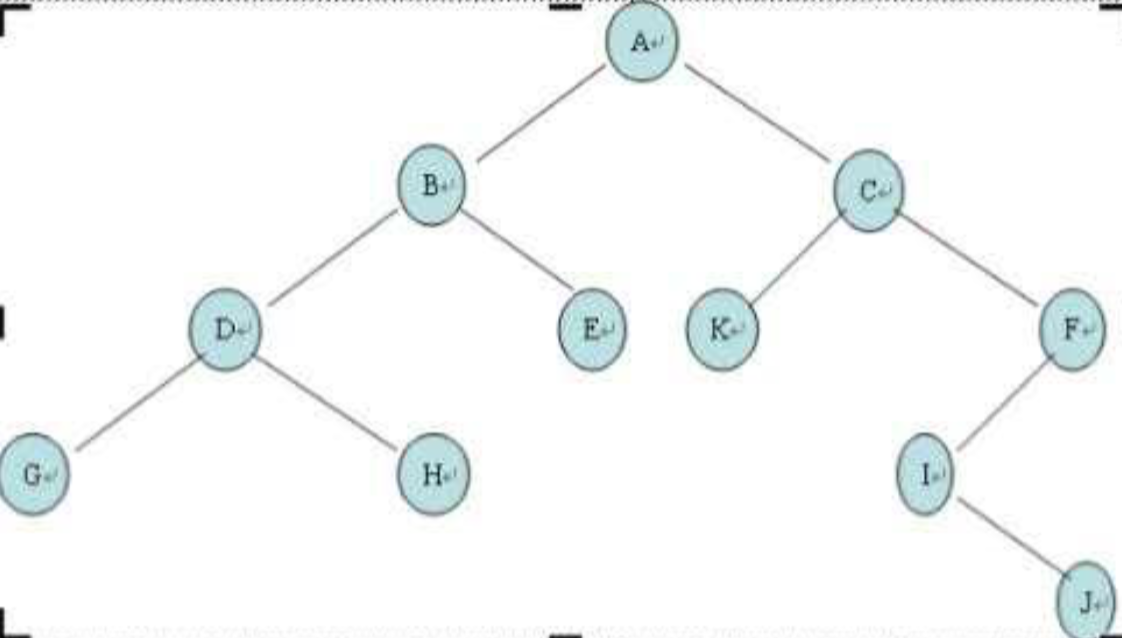二叉樹的遍歷及常用演算法
阿新 • • 發佈:2020-05-22
# 二叉樹的遍歷及常用演算法
## 遍歷的定義:
按照某種次序訪問二叉樹上的所有結點,且每個節點僅被訪問一次;
遍歷的重要性:
當我們需要對一顆二叉樹進行,插入,刪除,查詢等操作時,通常都需要先遍歷二叉樹,所有說:遍歷是二叉樹的基本操作;
## 遍歷思路:
- 二叉樹的資料結構是遞迴定義(每個節點都可能包含相同結構的子節點),所以遍歷也可以使用遞迴,即結點不為空則繼續遞迴呼叫
- 每個節點都有三個域,資料與,左孩子指標和右孩子之指標,每次遍歷只需要讀取資料,遞迴左子樹,遞迴右子樹,這三個操作
## 三種遍歷次序:
根據訪問三個域的不同順序,可以有多種不同的遍歷次序,而通常對於子樹的訪問都按照從左往右的順序;
設:L為遍歷左子樹,D為訪問根結點,R為遍歷右子樹,且L必須位於R的前面
可以得出以下三種不同的遍歷次序:
### 先序遍歷
操作次序為DLR,首先訪問根結點,其次遍歷 根的左子樹,最後遍歷根右子樹,對每棵子樹同樣按 這三步(先根、後左、再右)進行
### 中序遍歷
操作次序為LDR,首先遍歷根的左子樹,其次 訪問根結點,最後遍歷根右子樹,對每棵子樹同樣按 這三步(先左、後根、再右)進行
### 後序遍歷
操作次序為LRD,首先遍歷根的左子樹,其次 遍歷根的右子樹,最後訪問根結點,對每棵子樹同樣 按這三步(先左、後右、最後根)進行
### 層次遍歷
層次遍歷即按照從上到下從左到右的順序依次遍歷所有節點,實現層次遍歷通常需要藉助一個佇列,將接下來要遍歷的結點依次加入佇列中;
## 遍歷的應用
“遍歷”是二叉樹各種操作的基礎,可以在遍歷 過程中對結點進行各種操作,如:對於一棵已知二叉樹
- 求二叉樹中結點的個數
- 求二叉樹中葉子結點的個數;
- 求二叉樹中度為**1**的結點個數
- 求二叉樹中度為2的結點個數
- 5求二叉樹中非終端結點個數
- 交換結點左右孩子
- 判定結點所在層次
等等...
# C語言實現:
```text
#include
//二叉連結串列資料結構定義
typedef struct TNode {
char data;
struct TNode *lchild;
struct TNode *rchild;
} *BinTree, BinNode;
//初始化
//傳入一個指標 令指標指向NULL
void initiate(BinTree *tree) {
*tree = NULL;
}
//建立樹
void create(BinTree *BT) {
printf("輸入當前結點值: (0則建立空節點)\n");
char data;
scanf(" %c", &data);//連續輸入整形和字元時.字元變數會接受到換行,所以加空格
if (data == 48) {
*BT = NULL;
return;
} else {
//建立根結點
//注意開闢的空間大小是結構體的大小 而不是結構體指標大小,寫錯了不會立馬產生問題,但是後續在其中儲存資料時極有可能出現記憶體訪問異常(飆淚....)
*BT = malloc(sizeof(struct TNode));
//資料域賦值
(*BT)->data = data;
printf("輸入節點 %c 的左孩子 \n", data);
create(&((*BT)->lchild));//遞迴建立左子樹
printf("輸入節點 %c 的右孩子 \n", data);
create(&((*BT)->rchild));//遞迴建立右子樹
}
}
//求雙親結點(父結點)
BinNode *Parent(BinTree tree, char x) {
if (tree == NULL)
return NULL;
else if ((tree->lchild != NULL && tree->lchild->data == x) ||
(tree->rchild != NULL && tree->rchild->data == x))
return tree;
else{
BinNode *node1 = Parent(tree->lchild, x);
BinNode *node2 = Parent(tree->rchild, x);
return node1 != NULL ? node1 : node2;
}
}
//先序遍歷
void PreOrder(BinTree tree) {
if (tree) {
//輸出資料
printf("%c ", tree->data);
//不為空則按順序繼續遞迴判斷該節點的兩個子節點
PreOrder(tree->lchild);
PreOrder(tree->rchild);
}
}
//中序
void InOrder(BinTree tree) {
if (tree) {
InOrder(tree->lchild);
printf("%c ", tree->data);
InOrder(tree->rchild);
}
}
//後序
void PostOrder(BinTree tree) {
if (tree) {
PostOrder(tree->lchild);
PostOrder(tree->rchild);
printf("%c ", tree->data);
}
}
//銷燬結點 遞迴free所有節點
void DestroyTree(BinTree *tree) {
if (*tree != NULL) {
printf("free %c \n", (*tree)->data);
if ((*tree)->lchild) {
DestroyTree(&((*tree)->lchild));
}
if ((*tree)->rchild) {
DestroyTree(&((*tree)->rchild));
}
free(*tree);
*tree = NULL;
}
}
// 查詢元素為X的結點 使用的是層次遍歷
BinNode *FindNode(BinTree tree, char x) {
if (tree == NULL) {
return NULL;
}
//佇列
BinNode *nodes[1000] = {};
//佇列頭尾位置
int front = 0, real = 0;
//將根節點插入到佇列尾
nodes[real] = tree;
real += 1;
//若佇列不為空則繼續
while (front != real) {
//取出佇列頭結點輸出資料
BinNode *current = nodes[front];
if (current->data == x) {
return current;
}
front++;
//若當前節點還有子(左/右)節點則將結點加入佇列
if (current->lchild != NULL) {
nodes[real] = current->lchild;
real++;
}
if (current->rchild != NULL) {
nodes[real] = current->rchild;
real++;
}
}
return NULL;
}
//層次遍歷
// 查詢元素為X的結點 使用的是層次遍歷
void LevelOrder(BinTree tree) {
if (tree == NULL) {
return;
}
//佇列
BinNode *nodes[1000] = {};
//佇列頭尾位置
int front = 0, real = 0;
//將根節點插入到佇列尾
nodes[real] = tree;
real += 1;
//若佇列不為空則繼續
while (front != real) {
//取出佇列頭結點輸出資料
BinNode *current = nodes[front];
printf("%2c", current->data);
front++;
//若當前節點還有子(左/右)節點則將結點加入佇列
if (current->lchild != NULL) {
nodes[real] = current->lchild;
real++;
}
if (current->rchild != NULL) {
nodes[real] = current->rchild;
real++;
}
}
}
//查詢x的左孩子
BinNode *Lchild(BinTree tree, char x) {
BinTree node = FindNode(tree, x);
if (node != NULL) {
return node->lchild;
}
return NULL;
}
//查詢x的右孩子
BinNode *Rchild(BinTree tree, char x) {
BinTree node = FindNode(tree, x);
if (node != NULL) {
return node->rchild;
}
return NULL;
}
//求葉子結點數量
int leafCount(BinTree *tree) {
if (*tree == NULL)
return 0;
//若左右子樹都為空則該節點為葉子,且後續不用接續遞迴了
else if (!(*tree)->lchild && !(*tree)->rchild)
return 1;
else
//若當前結點存在子樹,則遞迴左右子樹, 結果相加
return leafCount(&((*tree)->lchild)) + leafCount(&((*tree)->rchild));
}
//求非葉子結點數量
int NotLeafCount(BinTree *tree) {
if (*tree == NULL)
return 0;
//若該結點左右子樹均為空,則是葉子,且不用繼續遞迴
else if (!(*tree)->lchild && !(*tree)->rchild)
return 0;
else
//若當前結點存在左右子樹,則是非葉子結點(數量+1),在遞迴獲取左右子樹中的非葉子結點,結果相加
return NotLeafCount(&((*tree)->lchild)) + NotLeafCount(&((*tree)->rchild)) + 1;
}
//求樹的高度(深度)
int DepthCount(BinTree *tree) {
if (*tree == NULL)
return 0;
else{
//當前節點不為空則深度+1 在加上子樹的高度,
int lc = DepthCount(&((*tree)->lchild)) + 1;
int rc = DepthCount(&((*tree)->rchild)) + 1;
return lc > rc?lc:rc;// 取兩子樹深度的 最大值
}
}
//刪除左子樹
void RemoveLeft(BinNode *node){
if (!node)
return;
if (node->lchild)
DestroyTree(&(node->lchild));
node->lchild = NULL;
}
//刪除右子樹
void RemoveRight(BinNode *node){
if (!node)
return;
if (node->rchild)
DestroyTree(&(node->rchild));
node->rchild = NULL;
}
int main() {
BinTree tree;
create(&tree);
BinNode *node = Parent(tree, 'G');
printf("G的父結點為%c\n",node->data);
BinNode *node2 = Lchild(tree, 'D');
printf("D的左孩子結點為%c\n",node2->data);
BinNode *node3 = Rchild(tree, 'D');
printf("D的右孩子結點為%c\n",node3->data);
printf("先序遍歷為:");
PreOrder(tree);
printf("\n");
printf("中序遍歷為:");
InOrder(tree);
printf("\n");
printf("後序遍歷為:");
PostOrder(tree);
printf("\n");
printf("層次遍歷為:");
LevelOrder(tree);
printf("\n");
int a = leafCount(&tree);
printf("葉子結點數為%d\n",a);
int b = NotLeafCount(&tree);
printf("非葉子結點數為%d\n",b);
int c = DepthCount(&tree);
printf("深度為%d\n",c);
//查詢F節點
BinNode *node4 = FindNode(tree,'C');
RemoveLeft(node4);
printf("刪除C的左孩子後遍歷:");
LevelOrder(tree);
printf("\n");
RemoveRight(node4);
printf("刪除C的右孩子後遍歷:");
LevelOrder(tree);
printf("\n");
//銷燬樹
printf("銷燬樹 \n");
DestroyTree(&tree);
printf("銷燬後後遍歷:");
LevelOrder(tree);
printf("\n");
printf("Hello, World!\n");
return 0;
}
```
##### 測試:
測試資料為下列二叉樹:

執行程式複製貼上下列內容:
```text
A
B
D
G
0
0
H
0
0
E
0
0
C
K
0
0
F
I
0
J
0
0
0
```
特別感謝
